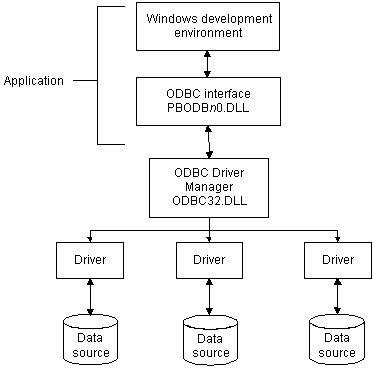When you access an ODBC data source in DataWindow Designer, your connection goes through several layers before reaching the data source. It is important to understand that each layer represents a separate component of the connection, and that each component might come from a different vendor.
Because ODBC is a standard API, DataWindow Designer uses the same interface to access every ODBC data source. As long as a driver is ODBC compliant, DataWindow Designer can access it through the ODBC interface to the ODBC Driver Manager. The plug-in and the ODBC interface work together as the application component.
Figure 2-1 shows the general components of an ODBC connection.
Figure 2-1: Components of an ODBC connection

Table 2-1 gives the provider and a brief description of each ODBC component shown in the diagram.
Component |
Provider |
What it does |
|---|---|---|
Application |
Sybase |
Calls ODBC functions to submit SQL statements, catalog requests, and retrieve results from a data source. DataWindow Designer uses the same ODBC interface to access all ODBC data sources. |
ODBC Driver Manager |
Microsoft |
Installs, loads, and unloads drivers for an application. |
Driver |
Driver vendor |
Processes ODBC function calls, submits SQL requests to a particular data source, and returns results to an application. If necessary, translates an application’s request so that it conforms to the SQL syntax supported by the back-end database. See “Types of ODBC drivers”. |
Data source |
DBMS or database vendor |
Stores and manages data for an application. Consists of the data to be accessed and its associated DBMS, operating system, and (if present) network software that accesses the DBMS. |